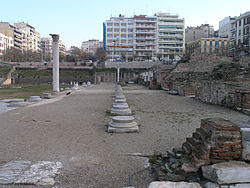Agora
Agora (from the Greek ἀγορά, assembly, from ἀγείρω, 'to gather'[citation needed]) is a term by which the square of the Greek city-states (polis) was designated in Ancient Greece, where the citizens used to congregate.
It was an open space, the center of commerce (market), culture and politics of the social life of the Greeks. It was usually surrounded by the most important private and public buildings, such as the stoas (columned porticoes), pritaneos (administrative offices), bouleterion (building for boulé meetings) and balaneia (baths).
Historical evolution
Historical precedents go back to the times of the plazas of Minoan Crete, where the first agoras have been located.
Later, it reappeared after the fall of the Mycenaean civilization and already since the 8th century BC. C., becoming an essential characteristic of all polis, animated by a great commercial activity. From that moment on, the agora (located in the lower city) will replace the institution of the fortress palace (located in the acropolis) in importance and will be the urban political center.
Archaic agoras are closely associated with religious shrines and entertainment activities such as parties, games, and theater.
With the passage of time, the agora became the beginning of the polis, both from an economic and commercial point of view (as the seat of the market), and from a religious point of view, since the places of worship of the founder were found there from the city or from the protective deity or from the political point of view as it is a meeting place for citizens to discuss community problems. In this way and around it, the public buildings necessary to house all the activities began to emerge.
The agora was a true urban invention, unprecedented neither in the centers of the Near East nor in the Mycenaean civilization where everything depended on the kings, so there was no need for meeting places.
This innovation was introduced thanks to the great urban modifications that began in the time of Pericles, around the 5th century BC. C., which over time, during the Hellenistic period, expanded to three main types of agora: the mercantile, in the maritime cities, in close connection with the ports, where the agora was located near the city gates and the political or religious, which placed it in the center of the city.
The most famous is the Agora of Athens. The Roman forum is the equivalent of the Agora and both are the predecessors of the current squares.
Contenido relacionado
Chinampa
History of christianity
Saint Sebastian

